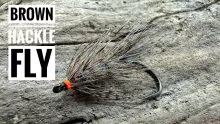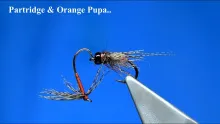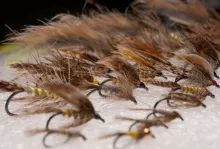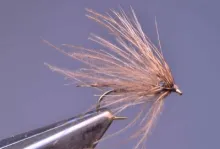Hen hackles have long been the source of confusion to many fly tyers. Whether they are looking for wings for their dry flies or hackles for their wet flies, there seems to plenty of head scratching when it comes time to purchase the appropriate feathers.
 Hen hackles are the choice material for a soft hackle collar, but to think that is their only purpose would be to limit your tying considerably. These all use hen: Adams, Soft Hackled Wooly Bugger, Black Ghost, Teal, Blue, and Silver, Light Caddis, Grey Hackle Peacock
Hen hackles are the choice material for a soft hackle collar, but to think that is their only purpose would be to limit your tying considerably. These all use hen: Adams, Soft Hackled Wooly Bugger, Black Ghost, Teal, Blue, and Silver, Light Caddis, Grey Hackle PeacockHen hackles have long been the source of confusion to many fly tyers. Whether they are looking for wings for their dry flies or hackles for their wet flies, there seems to plenty of head scratching when it comes time to purchase the appropriate feathers. A well supplied materials supplier will list a dizzying array of hen products, the use for each not immediately apparent. Your search is only beginning when you read that a fly recipe calls for hen hackle. Let's see if we can match some common uses of hen hackles with appropriate feathers.
Dry Flies - Hackle Tip Wings
One of the most common uses of hen hackle is for dry fly wings. Everyone wants to tie an Adams with perfectly shaped grizzly hackle wings that are as beautiful as they are functional. Hen hackles are easily the best choice for dry fly wings. The stems are flexible enough to allow the wings to "collapse" when cast, thus preventing undue leader twist. Most hen neck feathers have an obvious web line, which makes the wings more visible in the finished fly. Necks also have a large range of feather sizes, allowing for wings on various sized dry flies. Finally, a good hen neck will have hackles that have a fairly broad outline all the way to the tip with a rounded, rather than pointed, tip. If your intention is to purchase a hen neck for dry fly wings, you are well advised to purchase them in person so you can examine the shape of the feathers. If this is not an option, order from a trusted source and clearly explain that the neck will be used for dry fly wings. Not all genetic necks are good for dry fly wings - as some are too long and narrow with pointed tips - almost like cock hackle. Hen "pullet" capes are quite consistent in shape and texture and will typically create outstanding dry fly wings. Ask your supplier if they have access to pullet capes.
You won't be sorry.

Both of these hackles were taken from "genetic" hen necks, but this just goes to show that not all necks are created equal. The feather on the left would make a fine dry fly wing, while the one on the right is a little thin for a dry fly wing but would serve well for a palmered hackle.

Both of these hackles were plucked from necks sold as "salmon hen necks". One will be a pleasure to work with and one will be a constant source of frustration. Can you tell which is which?

Note the difference between a genetic hen neck hackle and an "indian" hen neck hackle. If you're intentions are to palmer a fly like a wooly worm or such, the genetic neck will serve you well. The indian necks are best left to hackle collars and false beards.

A hen saddle and a hen "back" feather. Both can serve similar purposes for nymph hackles, soft hackles, or certain dry fly wings. The back feather has the added advantage of being a mottled brown.
Dry Flies - Cut Wings
The cut wing is another style of dry fly wing that might be fading from popularity. If the wings are not properly matched, or if they are too stiff, they have a tendency to twist leaders like a corkscrew.
However, if some care is taken when choosing the base feathers and when trimming them to shape, these wings can be both functional, durable, and effective. What you are looking for in cut-wing feathers is a solid web and a flexible stem. The feather should not be "dense", however, as you'd find in schlappen or most rooster body feathers since this would make for a very heavy wing that would pose balance problems for your dry fly when it's time to fish it. For this reason, hen saddle feathers make outstanding raw material for cut wings.
They exhibit the solid web of other feathers, but it's a relatively thin and "light" webbiness compared to the others. They also typically have flexible stems, which allow the wings to move when the the fly is cast, helping to reduce the annoying leader twist associated with large and stiff dry fly wings. Whether you use wing burners or shape them with fingernail clippers, the results will be feathers than have the desired mayfly wing shape, while having softness and flexibility that allow them to be fished effectively.
Dry Flies - Caddis "Tent" Wing
Many people are tying caddis flies with tent wings made by gluing hackles to some sort of reinforcing material. Oliver Edwards, in his wonderful book Flytyer's Masterclass, describes a procedure he learned from Polish fly tyers for gluing soft hackles to a piece of stretched out nylon stocking. When dry, the stocking gives the wings a skeletal-type support to hold when makes them durable and able to hold their shape when cast and fished. The same technique has also been applied to hackles pressed onto a length of clear plastic waterproof tape. The tape serves the same function as the nylon stocking, yet is significantly easier to deal with and less time consuming. The downside is that it adds weight to the wing material, but with a downwing style fly, this is not as critical as a high winged mayfly where a heavy wing could cause the fly to tip on its side.
Genetic hen saddle feathers and indian hen "back" feathers are excellent sources of feathers for these "tent" wings. The hen back feathers, in particular, offer the mottled brown coloration found in many natural caddis adults. Hen saddles that are dyed to various shades of dun or brown can also make realistic tent style wings.
Wet flies and Palmers
Whether wound at the head as a full collar or tied underneath the head as a false beard, hen hackle and wet flies are like peas and carrots. With a few exceptions, for sunken flies you want a hackle that is soft. One that will absorb water and move well with the whims of current, quivering and giving off a suggestion of life. Hen hackle is well suited for this purpose. Whether you are tying colorful flies for wilderness brookies, or drab wets for snooty browns, there will be a hen hackle to serve the purpose.
Palmers, as the name suggests, as flies that have a hackle wound over the length of the body. There is no doubt in my mind that no area on the planet has more palmered wet flies than the UK. Bumbles, Zulus, Palmers, Goslings, and a host of others - all with a characteristic palmered hackle. While most UK tyers will use cock hackle, genetic hen hackle will serve the purpose as well, especially the higher grade necks from the premium brands. These hackles have the length to make the required wraps of hackle with a similar glossy sheen and stiffness to the lower grade cock necks normally used. For "American" palmered flies like wooly worms and such, genetic hen necks are preferred over the more commonly used saddle hackle.
Salmon Flies
Most salmon wet flies employ a hackle of some sort, whether a palmered body hackle, a hackle "beard" beneath the head, or a full hackle collar in front of the wing. While most tyers use chinese neck hackles for the palmered body hackle on salmon flies, some of the better quality genetic hen necks can also supply excellent hackles for this. For beards and hackle collars, I am partial to hen saddles since they are so webby and soft and move so well in the water when they are thoroughly soaked. In addition to hen saddles, you can find hen necks specially marketed to tyers of salmon flies. These so called "salmon" necks are usually dyed over white hen pullet necks. The are typically soft barbed and tie excellent collars and beards, but are not as heavy as a saddle feather. Choose these carefully - as not all hen products labeled "salmon" are the same. Some have very short hackles with long barbs, which make them particularly troublesome to use. They also tend to be very fragile. I use these mostly for flies which call for a false beard, where I can just pull off some barbs and won't have to worry about wrapped a very short feather with a brittle stem. The better salmon necks are easy to use and have hackles that come in a better range of sizes with longer stems which facilitate wrapping a hackle collar.
Damp Flies - Flymphs, and Emergers
With the popularity of Dave Hughes fine book Wet Flies, we might see a rebirth of the "flymph", a style of fly developed by Mr. James Leisenring on his home streams in Pennsylvania and captured in his book The Art of the Wet Fly co-authored with Vernon Hidy (check this). The flymph was designed to be a cross between a fly (dry fly, in this case) and a nymph. They are meant to be fished unweighted, drifting just beneath, and sometimes trapped in, the surface film of a stream where trout will be looking for emerging mayfly duns, crippled duns, and other bits of flotsam. As Dave so eloquently instructs, genetic hen necks provide prime feathers for tying flymphs, as well as a number of other "damp" flies. The better grade necks from genetic hackle growers can exhibit many characteristics otherwise found in cock hackles - a relatively stiff barbule (compared to other hen hackle types), suppleness of stem, and modest web.
Patterns featured in this article:
Adams
Soft Hackle Wooly Bugger
Black Ghost
Teal, Blue, and Silver
Light Caddis
Gray Hackle Peacock
TALK TO ME!
If you have interesting uses for hen hackle, write me and I'll update this feature with your thoughts and ideas.
- Log in to post comments














I'm trying to buy some feathers
i'm trying to buy some feathers for hair extensions and i need the softer feather and i need length, i want to know the difference between 1/4 saddle, 100 packs and full saddle. When ordering feathers i have read that the size isn't actually the length is that true? any info you can send is helpful
I am trying to find
I am trying to find a source for white hen pullet capes for dry fly wings down to size #22. Any suggestions?
What are the different places
What are the different places that saddle and spade hackle come from? What are the uses for saddle, spade, and neck hackles?
I am SO glad
I am SO glad to have found this article! I now have a much better understanding of the many uses of the many kinds of hen hackle.
Thank you Mr. Petti.